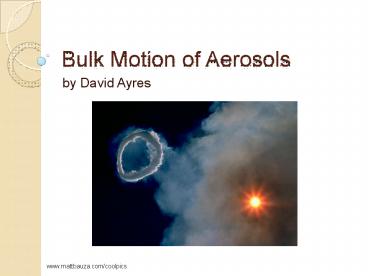Bulk Motion of Aerosols - PowerPoint PPT Presentation
1 / 25
Title:
Bulk Motion of Aerosols
Description:
Path of Least Resistance. depends on Cm. S FD. VTS. VC. Group discussion High Cm? ... Then, the ratio of cloud settling velocity to particle settling velocity is: ... – PowerPoint PPT presentation
Number of Views:128
Avg rating:3.0/5.0
Title: Bulk Motion of Aerosols
1
Bulk Motion of Aerosols
- by David Ayres
www.mattbauza.com/coolpics
2
Examples of Bulk Motion
www.chaos.org.uk
www.soest.hawaii.edu/HIGEAR
3
What is a bulk aerosol?
- Region of high aerosol concentration w/ a
definite boundary in a much larger region of
clean air. - a.k.a. Cloud
- Examples
- Cigarette smoke ring 30 g/m3
- Cloud (H2O) 1 g/m3
4
Cloud Settling
- VTS Settling velocity of one particle.
- VC Settling velocity of the cloud.
VTS
VTS
VC
VTS lt VC
5
Cloud Settling How can Vc gt VTS?
- Path of Least Resistance
- depends on Cm
S FD
- Low Cm
- Wind moves through.
FD
VTS
VC
Group discussion High Cm?
6
Cloud SettlingHow can Vc gt VTS?
- Now consider high Cm.
- Wind moves around.
S FD
FD, C
VTS
- Before calculating, must know cloud properties
VC
7
Cloud properties
- Depend on the bulk properties of the aerosol, not
the individual particles. - Viscosity
- Density
- Net Density
?C Cloud viscosity ?g Gas viscosity Cv
Particle volume concentration Cm Particle mass
concentration ?g Gas density ?C, abs Cloud
absolute density ?C Cloud net
density
- Advantage of net density?
8
Cloud Settling Velocity
- Settling velocity
- Should we calculate CD in the Stokes or Newton
region? Why is this a problem?
9
Cloud Drag Coefficient
- Use the equation
- Use Table 3.4 to find Re as a f(CDRe2).
- Solve for CD.
- For 4.4x105 lt CDRe2 lt 1.76x1010,
- CD 0.44.
- For Re lt 1,
- CD 24/Re.
Table 3.4 (Excerpt)a
Re f(99000) 403
a Source Hinds, 1999
10
Example Problem
- A spherical cloud of water droplets 5 m in
diameter has a mass concentration of 1 g/m3.
What is the terminal settling velocity of the
cloud?
11
Cloud vs. Particle Settling
- Recall
- Then, the ratio of cloud settling velocity to
particle settling velocity is
in the Stokes region (Re lt1)
Slip correction for the particles.
12
Minimum settling concentration
Table 17.1 Minimum Concentration for Cloud
Settling (G 1) at Standard Conditionsa
- How does minimum concentration change with
increasing cloud size? Does this make sense? - Are these settling velocities significant?
a Source Hinds, 1999
13
Settling velocity 1 cm/s
Table 17.2 Concentrations for a Cloud Settling
Velocity of 0.01 m/s 1 cm/s at Standard
Conditionsa
- How does mass conc. change with increasing cloud
size? Why? - What about conc.?
a Source Hinds, 1999
14
Life as a Cloud
- Assume clouds start like this
www.flickr.com, Esther17
but most end up like this.
- What gives?
www.icteacher.co.uk
15
Life as a Cloud
16
Bonus! (Non-quizzable)
- Rayleigh-Taylor instability
- Heavy fluid lies on top of light fluid.
- Heavy fluid breaks through.
- Light fluid accelerates
- heavy fluid.
- Needs a force field. What
- type is in the picture?
en.wikipedia.org
17
Reflection
But wait, theres more
18
Dust ExplosionsThe Basics
- by David Ayres
http//www.cdc.gov/niosh/nas/mining/
19
The more you know
- 40 dust explosions annually in U.S.
- Require 3 things
- Oxygen
- Ignition
- Fuel
- Coal
- Sawdust
- Powdered
- milk
Screen capture from Science Made Easy, by Henry
Brouwer
20
Dust vs. Gas
Figure 18.2 Range of explosive concentrations in
air.a
- Based on the figure, why is dust more dangerous
than gas?
a Source Hinds, 1999
21
Dust vs. Gas (cont.)
- Gas Detonation Shock wave due to very fast
flame speed. - Dust Deflagration Slow flame catches newly
suspended dust kicked up by faster sound wave.
22
General Properties
Figure 18.3 Effect of particle size on minimum
explosive concentration.a
Minimum explosive concentration, g/m3
Particle diameter, µm
- Minimum conc. decreases as ease of volatilization
increases.
a Source Hinds, 1999
23
General Properties (cont.)
Table 18.1 Explosive characterists of selected
dusts (excerpt).a
- What makes a material more hazardous?
a Source Hinds, 1999
24
Prevention
- Control ignition sources.
- Properly ground equipment.
- Frequently clean up dust.
- Ventilation and monitoring.
- Segregate dangerous operations.
25
Reflection































